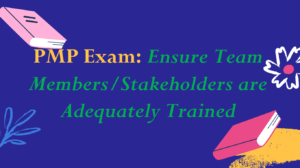PMP Exam: Ensure Team Members/Stakeholders are Adequately Trained
Ensure Team Members/Stakeholders are Adequately Trained is part of People topics in the PMP exam. In project management, identifying training needs is crucial for ensuring that team members and stakeholders have the necessary skills and knowledge for project success. This involves assessing current competencies and comparing them with the requirements of the project to pinpoint any gaps. The process helps in determining the specific training that is needed to address these deficiencies.

Developing a Training Plan
Once training needs are identified, a comprehensive and detailed training plan must be developed. This plan should meticulously outline the specific content to be covered, including all relevant topics and subtopics, the various methods of delivery (such as interactive workshops, online courses, webinars, or hands-on practice sessions), and the precise schedule for training sessions. Additionally, it should include information on the resources required, such as trainers, materials, and technology, as well as any assessments or evaluations to measure the effectiveness of the training. The primary goal is to create a well-structured and organized approach that aligns seamlessly with the overall project’s timeline and objectives, ensuring that all training activities are completed both efficiently and effectively, thereby maximizing the potential for successful implementation and long-term benefits.
Implementing the Training
The implementation phase is a crucial step that involves the careful and strategic allocation of various resources, including time, budget, and materials, to effectively conduct the training program. During this phase, it’s essential not only to provide the necessary resources but also to ensure active participation and engagement from all involved parties, including team members and stakeholders. This phase is critical for translating the training plan into actionable steps and equipping everyone involved with the necessary skills and knowledge. Additionally, it involves continuous monitoring and adjustments to ensure that the training objectives are being met and that any challenges encountered are promptly addressed. By doing so, the implementation phase ensures that the training program is successful and that all participants are well-prepared to apply what they have learned in their respective roles.
Monitoring and Evaluation
After training is conducted, it’s important to carefully monitor and thoroughly evaluate its effectiveness over a period of time. This involves not only collecting feedback from participants but also systematically assessing any improvements in their performance and knowledge retention. Evaluating the success of the training program helps in understanding whether the predefined training objectives were successfully met and in identifying specific areas that might require further improvement or additional training. Regular follow-up sessions and periodic reviews can also be beneficial to ensure the training has a lasting impact and continues to contribute to the organization’s goals.
Continuous Improvement
Training is an ongoing process, and continuous improvement is necessary for long-term success. It involves not only the initial education but also the continuous reinforcement and expansion of skills and knowledge over time. Providing post-training support and resources allows team members and stakeholders to apply what they’ve learned in real-world scenarios, ensuring that the training is practical and beneficial. This support can include access to additional materials, follow-up sessions, and mentorship opportunities. Based on feedback and evaluation results, adjustments to the training plan may be made to address any identified issues and enhance future training efforts. This iterative approach ensures that the training remains relevant, effective, and aligned with the evolving needs of the organization and its employees.
